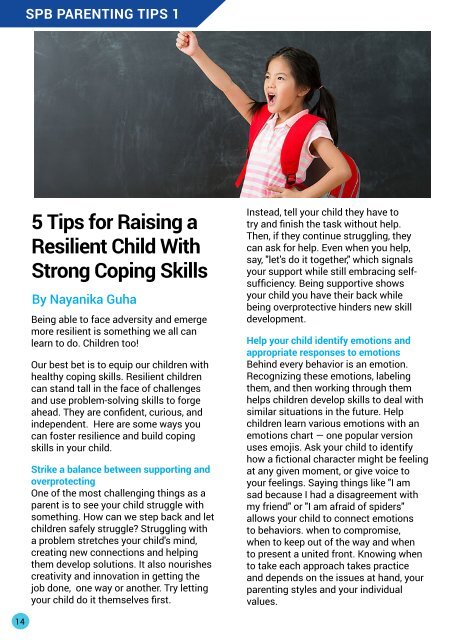CATALYST | October 2022
Monthly insight of student and teacher activities at SPK Sekolah Pelita Bangsa Cirebon
Monthly insight of student and teacher activities at SPK Sekolah Pelita Bangsa Cirebon
Create successful ePaper yourself
Turn your PDF publications into a flip-book with our unique Google optimized e-Paper software.
SPB PARENTING TIPS 1<br />
5 Tips for Raising a<br />
Resilient Child With<br />
Strong Coping Skills<br />
By Nayanika Guha<br />
Being able to face adversity and emerge<br />
more resilient is something we all can<br />
learn to do. Children too!<br />
Our best bet is to equip our children with<br />
healthy coping skills. Resilient children<br />
can stand tall in the face of challenges<br />
and use problem-solving skills to forge<br />
ahead. They are confident, curious, and<br />
independent. Here are some ways you<br />
can foster resilience and build coping<br />
skills in your child.<br />
Strike a balance between supporting and<br />
overprotecting<br />
One of the most challenging things as a<br />
parent is to see your child struggle with<br />
something. How can we step back and let<br />
children safely struggle? Struggling with<br />
a problem stretches your child's mind,<br />
creating new connections and helping<br />
them develop solutions. It also nourishes<br />
creativity and innovation in getting the<br />
job done, one way or another. Try letting<br />
your child do it themselves first.<br />
Instead, tell your child they have to<br />
try and finish the task without help.<br />
Then, if they continue struggling, they<br />
can ask for help. Even when you help,<br />
say, "let's do it together," which signals<br />
your support while still embracing selfsufficiency.<br />
Being supportive shows<br />
your child you have their back while<br />
being overprotective hinders new skill<br />
development.<br />
Help your child identify emotions and<br />
appropriate responses to emotions<br />
Behind every behavior is an emotion.<br />
Recognizing these emotions, labeling<br />
them, and then working through them<br />
helps children develop skills to deal with<br />
similar situations in the future. Help<br />
children learn various emotions with an<br />
emotions chart — one popular version<br />
uses emojis. Ask your child to identify<br />
how a fictional character might be feeling<br />
at any given moment, or give voice to<br />
your feelings. Saying things like "I am<br />
sad because I had a disagreement with<br />
my friend" or "I am afraid of spiders"<br />
allows your child to connect emotions<br />
to behaviors. when to compromise,<br />
when to keep out of the way and when<br />
to present a united front. Knowing when<br />
to take each approach takes practice<br />
and depends on the issues at hand, your<br />
parenting styles and your individual<br />
values.<br />
Ensure your child knows the appropriate ways to respond<br />
to the emotions they feel. Instead of scolding your child<br />
when they’re angry, guide them by helping them identify<br />
their feelings to build resiliency. If a child is angry about<br />
something, use a time-in. Be with your child in that difficult<br />
moment and identify what you see. Never push a child to<br />
talk; stay "in the moment" until they are in a stable place to<br />
talk.<br />
Encourage children to solve their problems<br />
Our children face many daily issues, from our little ones<br />
learning how to tie their shoelaces to our teens dealing with<br />
a breakup. Replace rescuing with coping skill education to<br />
help them learn to help themselves. Provide a coping skills<br />
box with a list of activities or items to help soothe strong<br />
emotions. Being able to solve their problems not only helps<br />
build coping skills and resiliency, but also increases selfconfidence<br />
and self-esteem.<br />
Model the skills and behavior you want children to exhibit<br />
Your child may not always listen to what you have to<br />
say, but they are always observing and learning from<br />
your actions. Observational learning refers to learning by<br />
observing others, retaining the information, and replicating<br />
later. We see this most often in toddlers. Think of how a<br />
child imitates funny faces you make at them.<br />
Show children how to sequence the emotional regulation<br />
steps to ensure they embrace the emotion, label it,<br />
and move forward appropriately. Co-regulation models<br />
appropriate identification and response to emotions while<br />
helping to maintain balance for your mental wellness.<br />
Help children identify their threshold and set their<br />
boundaries<br />
If you sense your child becoming overly frustrated, identify<br />
physical symptoms you are seeing and offer solutions<br />
supporting their struggle. Ensure children are in a balanced<br />
emotional state before being asked to complete a difficult<br />
task independently. It’s essential to set up the environment<br />
to embrace a healthy struggle so children feel a sense of<br />
accompaniment even when they cannot find a solution<br />
independently.<br />
Children with strong emotional regulation skills can identify<br />
coping skills to help them bring balance to their world. They<br />
use activities that foster calm and balance. Parents who<br />
co-regulate with their children promote independence in<br />
problem-solving and in working through difficult moments.<br />
14<br />
Source:<br />
15
















